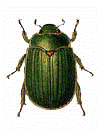Museum, University of Nebraska State
Document Type
Article
Date of this Version
8-30-2023
Citation
Chaboo CS, Adam S, Nishida K, Schletzbaum L (2023) Architecture, construction, retention, and repair of faecal shields in three tribes of tortoise beetles (Coleoptera, Chrysomelidae, Cassidinae: Cassidini, Mesomphaliini, Spilophorini). In: Chaboo CS, Schmitt M (Eds) Research on Chrysomelidae 9. ZooKeys 1177: 87–146. https://doi.org/10.3897/ zookeys.1177.102600
Abstract
Animal constructions are the outcomes of complex evolutionary, behavioural, and ecological forces. A brief review of diverse animal builders, the materials used, and the functions they provide their builders is provided to develop approaches to studying faecal-based constructions and faecal-carrying in leaf beetles (Coleoptera: Chrysomelidae). Field studies, rearing, dissections, photography, and films document shields constructed by larvae in two species in two tribes of the subfamily Cassidinae, Calyptocephala attenuata (Spaeth, 1919) (Spilophorini), and Cassida sphaerula Boheman, 1853 (Cassidini). Natural history notes on an undetermined Cassidini species and Stolas cucullata (Boheman, 1862) (Tribe Mesomphaliini) outline the life cycle of tortoise beetles and explain terms. Commonly, the cassidine shield comprises exuviae onto which faeces are daubed, producing a pyramidal-shaped shield that can cover most of the body (up to the pronotum). In Cal. attenuata the larval shield comprises only exuviae, while in Cass. sphaerula, instar 1 initiates the shield by extending its telescopic anus to apply its own faeces onto its paired caudal processes; at each moult the exuvia is pushed to the caudal process base but remains attached, then more faeces are applied over it. The larva’s telescopic anus is the only tool used to build and repair the shield, not mouthparts or legs, and it also applies chemicals to the shield. Pupae in Cal. attenuata retain part of the exuviae-only shield of instar VI, while pupae in Cass. sphaerula retain either the entire 5th instar larval shield (faeces + all exuviae) or only the 5th larval exuvia. The caudal processes are crucial to shield construction, shield retention on the body, and as materials of the central scaffold of the structure. They also move the shield, though the muscular mechanism is not known. Altogether the faecal + exuviae shields may represent a unique morpho-behavioural synapomorphy for the crown-clade Cassidinae (10 tribes, ~ 2669 species) and may have been a key innovation in subsequent radiation. Defensive shields and domiciles may help explain the uneven radiation of chrysomelid subfamilial and tribal clades.



Comments
Open access.